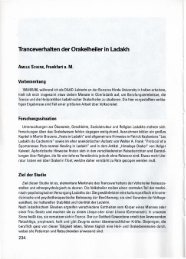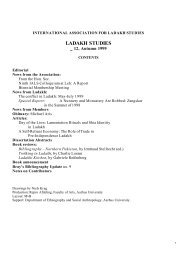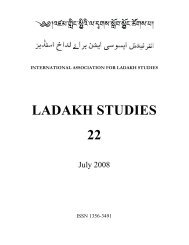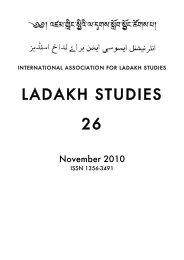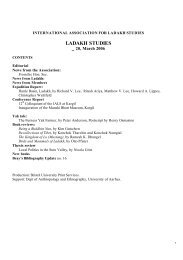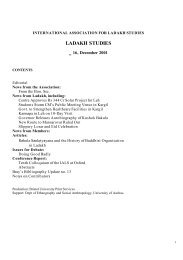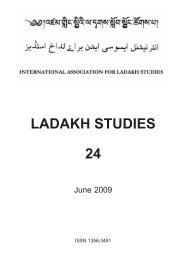LADAKH STUDIES 14, Autumn 2000 - International Association for ...
LADAKH STUDIES 14, Autumn 2000 - International Association for ...
LADAKH STUDIES 14, Autumn 2000 - International Association for ...
You also want an ePaper? Increase the reach of your titles
YUMPU automatically turns print PDFs into web optimized ePapers that Google loves.
ARTICLE<br />
Richard V. Lee, M.D.<br />
SOME OBSERVATIONS ON INFECTIOUS DISEASES<br />
AMONG ZANSKAR VILLAGERS<br />
To the usual touring trekker on the trail between Lamayuru and Padum, Ladakhi villagers are<br />
hardy, hard-working folk, blessed with health and happiness by the pristine mountain country and an<br />
abiding faith in Buddhism. Appearances of course are deceiving. Over the past <strong>14</strong> years the State<br />
University of New York at Buffalo has organized self-supporting medical expeditions to Kashmir<br />
and to Ladakh (map) (Table 1). In order to record changes in health and development of villages<br />
beyond the reach of roadways <strong>for</strong> motorized vehicles, we have visited each village several times.<br />
Because most infectious diseases are treatable with relatively short courses of antibiotics we have<br />
emphasized the detection and treatment of infections in our clinical work.<br />
Microbiologic diagnoses in the field are difficult and cumbersome. Serologic tests <strong>for</strong> antibodies<br />
circulating in the blood, skin tests <strong>for</strong> cell-mediated immunity, and simplified screening tests <strong>for</strong><br />
select pathogens, like group A streptococci, are feasible and useful in understanding the infectious<br />
disease burden of a small community. However, there can be tenacious resistance to taking blood<br />
samples or giving skin tests among villagers unfamiliar with Western medicine, so that serologic and<br />
intradermal tests may be impossible to obtain. There<strong>for</strong>e, most of the time clinical diagnoses, not<br />
microbiologic identification, are our standard reporting terms <strong>for</strong> infectious diseases.<br />
Eyes and skin:<br />
There are few places on earth where the external surfaces of the body are exposed to conditions so<br />
uniquely hostile to the integument and the eyes. Dryness, wind, dust, extremes of heat and cold, and<br />
intense ultraviolet radiation contribute to weathering. Red, chapped hands and faces, early<br />
cataracts, and conjunctival inflammation are the results. Ladakhi villagers dress <strong>for</strong> the climate and<br />
remain with most of their skin covered throughout the year, a practice that may contribute to vitamin<br />
D deficiency and rickets.<br />
Among children scabies and impetigo are common findings. Bathing by whole immersion is not<br />
desirable in the villages so skin cleansing can be infrequent. The accumulation of natural oils can<br />
diminish the weathering effects, but contributes to the maintenance of superficial skin infections. I<br />
have not seen or been told about children with hematuria and edema suggesting post-streptococcal<br />
glomerulonephritis; but considering the reports about rheumatic heart disease I am sure the risk is<br />
present.<br />
Gastrointestinal infections:<br />
Diarrheal disease is common among children following weaning from the breast. Everyone in<br />
Zanskar drinks tea (butter tea, sweet tea, herbal tea, etc.) and chang (1), relatively safe liquids in<br />
terms of infectious potential, practices that account <strong>for</strong> a diminishing incidence of diarrhea in older<br />
children and adults, compared to communities where unboiled water, unpasteurized milk, and<br />
nonfermented beverages are used. Milk, meat, and eggs, common sources of gastrointestinal<br />
pathogens, are not prominent constituents of the Zanskari diet (2, 3). Diarrheal disease amongst<br />
children was more of a problem in the Warwan Valley of Kashmir (4-6), where we had thought to<br />
bring the rotavirus vaccine be<strong>for</strong>e it was taken off the market in North America.<br />
Hepatitis B seems to be uncommon in Zanskar. None of the villagers we have tested have<br />
antibody against hepatitis B virus. Hepatitis A, however, is very common. About 85% of our small<br />
sample had antibody against hepatitis A virus. Many of the people tested were in their teens<br />
suggesting that hepatitis A is a common, relatively benign, childhood disease that circulates in small<br />
village outbreaks. Hepatitis A, so-called infectious hepatitis, is spread by food contaminated by the<br />
25




